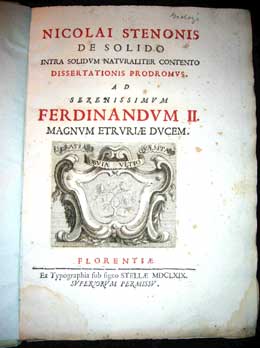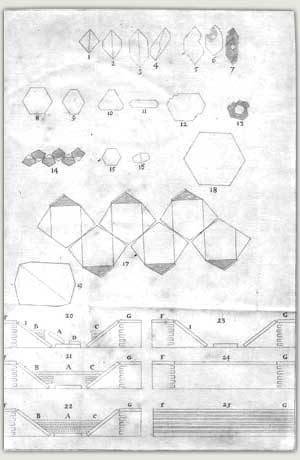Highlights

STENO [STENSEN], Nicolaus (Niels) (1638-1686)
De Solido intra Solidum Naturaliter
Contento Dissertationis Prodromus
Florence: Typographia sub signa Stellae, 1669.
 F
F
irst edition, of this foundation work in geology. The ancient belief that fossils are merely imitative forms of natural organisms produced by a ‘plastic force’ in the earth had first been challenged by Leonardo da Vinci, who declared that fossil shells are in fact remains of organisms that once lived. Fracastoro had similar ideas and Agricola did work on the same lines. But the greatest advance in this field is due to Steno.
In A Dissertation concerning a Solid Body, he described the composition of the earth’s crust in Tuscany and a famous diagram in his book shows six successive types of stratification: the first attempt ever made to represent geological sections. This was a sequence which he believed would be found all over the world. He explained the true origin of fossils found in the earth as being remains of once living things and he discriminated between the volcanic, chemical and mechanical modes of the origin of the rocks. He was the first clearly to recognize that the strata of the earth’s crust contain the records of a chronological sequence of events from which the history of the earth can be reconstructed.
 He attempted to find the principles of stratigraphy. Seeing that most strata had not remained in their horizontal position, he attributed their disturbance and tilting to the collapse of cavernous spaces below them and to volcanic action. He deduced that these changes in the original position of the strata are the real causes of the unevenness of the earth’s surface. This was in direct contradiction to the accepted belief that mountains had existed ever since the beginning of things or had simply grown. He also recognized that some mountains had been shaped by denudation and explained how one of the effects of the dislocation of the strata was the opening of fissures through which water could escape, the origin of springs.
He attempted to find the principles of stratigraphy. Seeing that most strata had not remained in their horizontal position, he attributed their disturbance and tilting to the collapse of cavernous spaces below them and to volcanic action. He deduced that these changes in the original position of the strata are the real causes of the unevenness of the earth’s surface. This was in direct contradiction to the accepted belief that mountains had existed ever since the beginning of things or had simply grown. He also recognized that some mountains had been shaped by denudation and explained how one of the effects of the dislocation of the strata was the opening of fissures through which water could escape, the origin of springs.
Steno’s book marks a great advance in geology and it cleared the path for the modern sciences of palaeontology and geology as they were gradually established by Leibniz, Lamarck, and James Hutton. The De Solido was intended only as an introduction to a larger work; but this was never written.
Steno also made important and original observations on the forms and manner of formation of crystals. He also did important work on the anatomy of glands, muscles, heart and brain.
Steno was born in Copenhagen and studied medicine there and then travelled extensively in Europe before settling in Florence as physician to the Grand Duke Ferdinand II. While there, he became converted to Catholicism in 1667. He was appointed Vicar Apostolic for the ‘Northern Missions’ and died at Schwerin in 1686.

